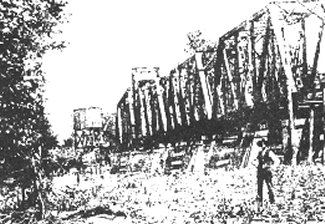

For the Boone County Historical & Railroad Society
| I |
In his letter of March 17, 1927, Mr. Armstrong writes about the pivot pier settling on the White River bridge at Georgetown, Arkansas. Apparently, the Weather Bureau had a river flood gauge on the pier and was worried about the accuracy of recent readings. The letter stated that the pier settled all at once after the January flood and thus the measurements during the flood were accurate. Mrs. Armstrong also wrote that the gauge was extended higher from 22 feet to 30 feet, placing this extension on the concrete base of the water tower and to be used only for water over 22 feet (presumably for flood waters above the top of the pier). The letter finally states that the pivot pier was being strengthened and the gauge would be reinstalled.
This bridge apparently was a major headache. Built by Wisconsin Bridge and Iron, it included two 125-foot through truss spans, a 60-foot deck plate girder approach span, and a 300-foot through truss turn span. A number of timber bridges were also needed to cross the sloughs at the bridge’s approaches. Dr. Fair states in his book that the bridge was damaged during the main flooding in April of 1927 and that the bridge actually began to lean. Again, it was the pivot pier affected. Apparently, repairs took until November of that year to correct the problem.
The pier never seemed to be right after the floods. The 1946 ICC report on the line indicated that the pier needed to again be repaired or replaced. Today the bridge is gone. Of all the through truss bridges between Leslie and Cotton Plant, the White River bridge was the only one removed during abandonment.